Tucson-based Minerals Research Inc. is probably not a familiar operation for most Cottonwood residents, but the slag pile the company is processing in the center of town certainly hasn’t escaped anyone’s notice — for generations, in fact.
The 60-foot pile of iron by-product is nearly a century old, the unsightly remnant of copper mining, an industry that helped define the communities of the Verde Valley.
Occupying approximately two acres behind the Verde Valley Fairgrounds, the slag is composed mainly of an iron silicate — essentially “iron glass,” according to Minerals Research Cottonwood site
Operations Manager Tom Hurkett.
Up and running since 2015, Minerals Research physically processes the slag. The aggregate is used to make abrasives for sandblasting and water jet cutting, heavyweight concrete, roofing materials and fill for astro turf and asphalt.
In a year, the operation runs about 50,000 to 60,000 tons to domestic markets, including naval bases in Guam and Japan.
The site employs about 20 people, Hurett said — less than might be assumed, but he added that the processing and packaging plants are fairly mechanized, mitigating the personnel needed to run the operation. A robot arm in the packaging plant, for instance, can create a 3,000-pound pallet of 75-pound bags of processed slag in 100 seconds, faster than the other machinery can keep up.
Hurkett said that, based upon historic market predictions, the pile will likely be processed within 15 to 20 years, though he admitted this number is subject to one particular factor that Minerals Research can’t predict: The full extent of the material they’re processing.
“The amount of slag here is unknown,” Hurkett said as he surveyed the moon-like panorama atop the pile. “We’ve done an aerial survey, of course, [but] there’s rumor there was a hole made. There could be more slag than we estimate.”
Likely, the hole Hurkett referred to is a tall tale passed down by families in the mining industry, but Minerals Research isn’t ruling out the possibility that the ground underneath the pile is not level.
Perhaps, Hurkett said, it is a hole or a bowl-shaped depression. The cost to do a core drilling to determine for sure, he added, is prohibitive.
Unknowns aside, it is a lucrative business, the result of Minerals Research locating slag from a single-source smelter.
“The smelter here processed only ore from Jerome,” Hurkett said. “This is a relatively small slag pile, but it’s consistent.”
Hurkett said that, though the pile is diminutive compared to others in the state, processing it in two acres is a challenge. When Minerals Research came in, crews had to clear a hole in the pile simply to have a place for the plants and offices.
In addition to moving machinery in a small space, Hurkett has tried to make sure the community is somewhat shielded from the activity.
“Obviously, we’re doing a very industrial process in a city,” Hurkett said. “That produces a problem in itself [but] I think overall it’s gone well. The city and community have been very accepting.”
Hurkett pointed to the extensive piping that wraps around the processing plant, describing the variety of ways in which the dust collectors keep emissions at a minimum. According to Hurkett, the plant is attempting to, and largely succeeding at, having zero emissions.
Ultimately, the biggest risk to the operation is mechanical. Slag aggregate is an extremely abrasive substance that wears down parts as fast as they can be repaired. A steel shop, located next to the packaging plant, is in constant use as crew members fix and fabricate new equipment to keep up.
“This is a maintenance-heavy process,” Hurkett said, pointing to a pile of processed slag. “This stuff destroys everything.”


